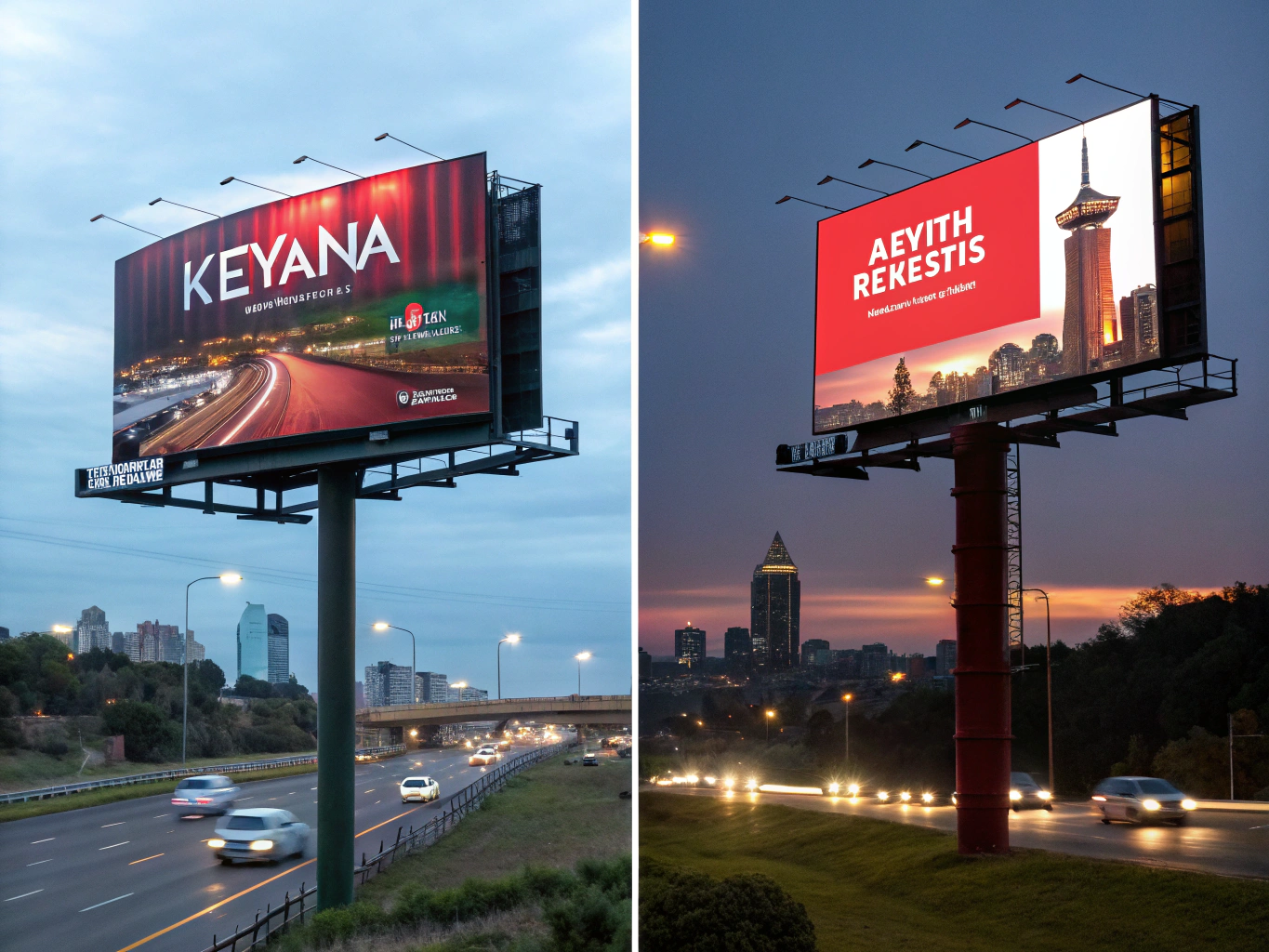Digital Billboards vs. Static Billboards: Which One Drives Better ROI?
In today’s fast-paced advertising world, choosing the right type of billboard can significantly impact your campaign’s return on investment (ROI). With traditional static billboards and dynamic digital billboards both competing for marketers’ attention, it’s essential to understand how each performs. This comprehensive guide explores the pros, cons, and ROI potential of digital billboards vs. static billboards, helping you make an informed choice for your advertising strategy.
Understanding the Basics
What Are Static Billboards?
Static billboards are traditional, printed advertisements mounted on large structures in high-traffic areas. They display a single message continuously for a specific duration (typically 4–8 weeks).
Key Characteristics:
- Non-digital, printed vinyl or painted ads
- 24/7 display without rotation
- Common in highways, urban roads, and rooftops
Traditional Use Cases:
- Brand awareness
- Long-term campaigns
- Political and public service announcements
What Are Digital Billboards?
Digital billboards are electronic displays that show multiple messages in rotation. Using LED technology, they allow real-time content changes and can be programmed based on time, weather, traffic, or event triggers.
Key Characteristics:
- Bright, high-resolution screens
- Multiple ads per location
- Remote and real-time control
Growth of DOOH (Digital Out-of-Home):
- Increasing adoption in urban centers
- Integration with data and automation
- Popular for short-term, event-driven, or dynamic campaigns
Initial Costs and Setup
Installation Costs for Static Billboards
- Lower setup cost compared to digital
- Requires printing, transport, and manual installation
- Ongoing costs include replacement and maintenance
Digital Billboard Costs
- Higher upfront cost due to LED display technology
- Requires electricity, software, and digital media creation
- Longer lifespan and lower content switch costs over time
Licensing and Maintenance
- Static: Lower energy use, simple permitting
- Digital: Stricter zoning, electricity, and digital maintenance
Audience Engagement and Visibility
Static Billboards: Tried and Tested
- Long dwell time due to consistent messaging
- Ideal for brand reinforcement
- Visibility depends on lighting and design
Digital Billboards: Eye-Catching and Interactive
- Bright visuals and movement increase engagement
- Dynamic ads perform better during peak hours
- Enables dayparting for precise audience targeting
Impact of Motion and Timing
- Studies show motion graphics increase recall by up to 83%
- Strategic timing (rush hour, evening) boosts impressions
Content Flexibility and Customization
Static Billboard Content
- One message for extended periods
- Limited flexibility once printed
- Higher cost for frequent message changes
Digital Billboard Content
- Schedule multiple messages daily
- Real-time updates for promotions or news
- Seasonal and event-based targeting
Use Cases
- Emergency announcements (digital)
- Seasonal promotions (digital)
- Corporate campaigns (static or digital)
Targeting and Scheduling Capabilities
Static Billboards: Set and Forget
- Limited targeting beyond geographic placement
- Always-on display 24/7
Digital Billboards: Dynamic Targeting
- Rotate ads based on audience time blocks
- Sync with mobile, weather, traffic, or local events
- Ideal for programmatic advertising strategies
Performance Metrics and Measurability
Static Billboard Measurement Challenges
- Difficult to track impressions and conversions
- Indirect metrics: traffic counts, brand lift studies
Digital Billboard Analytics
- Track real-time impressions using sensors and cameras
- Integration with mobile and digital campaigns
- Use QR codes, short URLs, or geofencing for ROI tracking
Attribution Options
- A/B testing ad creatives
- Integrating with Google Analytics or Meta Pixels
Cost Per Impression (CPM) and ROI Breakdown
Static Billboard CPM
- Average CPM ranges from $2 to $8
- Cheaper in rural or less trafficked areas
Digital Billboard CPM
- Ranges from $8 to $20 depending on city and rotation frequency
- Higher initial cost, lower long-term message cost
ROI Benchmarks
- Digital: Higher ROI for short-term and time-sensitive campaigns
- Static: Better for budget-conscious, long-term awareness
Case Studies & Real-World Examples
Local Business: Static Billboard Success
- Small bakery used a static highway billboard
- Result: 20% increase in foot traffic over 6 weeks
National Brand: Digital Billboard ROI
- Telecom company ran dynamic DOOH campaign in 5 cities
- ROI: 5x return, with 40% increase in app downloads
Hybrid Strategy Example
- Automotive brand used both formats
- Static: Reinforce branding
- Digital: Announce limited-time offers
Pros and Cons Summary
Static Billboard Pros
- Cost-effective
- Consistent messaging
- High visibility in local areas
Static Billboard Cons
- No real-time updates
- Hard to measure engagement
Digital Billboard Pros
- Dynamic content
- Real-time targeting
- Better analytics
Digital Billboard Cons
- Higher initial cost
- More regulations and technical maintenance
Decision Matrix
| Factor | Static | Digital |
|---|---|---|
| Budget Friendly | ✅ | ❌ |
| Dynamic Content | ❌ | ✅ |
| Time-Based Ads | ❌ | ✅ |
| Brand Awareness | ✅ | ✅ |
| ROI Tracking | ❌ | ✅ |
Which Is Right for You?
Consider Your Goals
- Branding vs. Promotions
- Short-term vs. Long-term campaigns
Evaluate Your Audience
- Urban digital-savvy consumers: Digital billboards
- Rural or highway travelers: Static billboards
Budget Constraints
- Static billboards offer great entry-level exposure
- Digital billboards offer scalable and measurable value
Industry Recommendations
- Real Estate, Events: Digital
- FMCG, Construction: Static
- Automotive, Retail: Both (hybrid strategy)
Future Trends in Outdoor Advertising
DOOH Growth
- 14% annual growth rate projected globally
- Adoption of AI and machine learning in targeting
Smart Billboards and Interactivity
- Facial recognition for demographics
- Interactive ads via mobile integration
Sustainability and Green Advertising
- Digital uses less printing waste
- Solar-powered digital billboards emerging
Our Thoughts
Both static and digital billboards have distinct advantages. When it comes to ROI, digital billboards offer better targeting, flexibility, and measurement, but static billboards remain cost-effective and impactful for long-term campaigns. The best approach? Match your goals and audience to the right format — or combine both for maximum effect.
Are you planning your next outdoor campaign? Let us help you pick the billboard format that delivers the best ROI. Contact our team for a free consultation or explore our services to learn more. email visturecompany@gmail.com Call/Whatsapp +254 116 535 179
digital billboards, static billboards, ROI, outdoor advertising, DOOH, billboard advertising, return on investment, digital out-of-home, programmatic advertising, billboard CPM, advertising metrics, static vs. digital billboards, content flexibility, billboard costs, measurable advertising campaigns.



